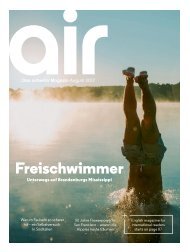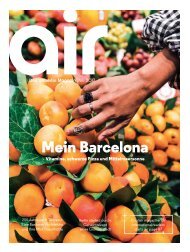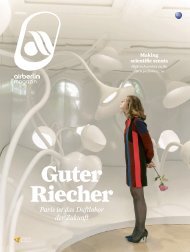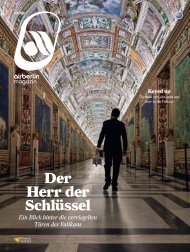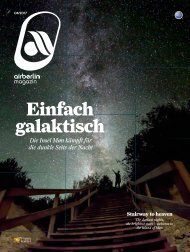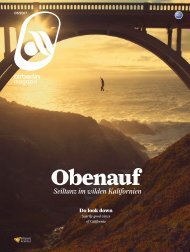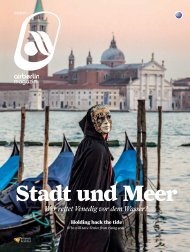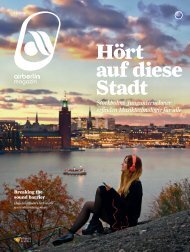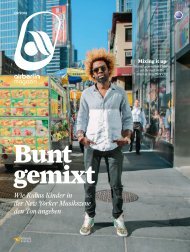Januar 2017 airberlin magazin - Hallo Kuh!
Erfolgreiche ePaper selbst erstellen
Machen Sie aus Ihren PDF Publikationen ein blätterbares Flipbook mit unserer einzigartigen Google optimierten e-Paper Software.
TRADITION / FINNLAND<br />
61<br />
kreises besucht hat. Jetzt steht er im Kiefernhain<br />
neben dem Hotel und scheint den Bäumen zu lauschen.<br />
Seine Arbeit als Archivar in Helsinki hat<br />
er vor drei Jahren aufgegeben. Jetzt macht er eine<br />
Ausbildung zum Schamanen. „Beim Schamanismus<br />
geht es darum, so viel Zeit wie möglich in der<br />
Natur zu verbringen“, sagt er. „Die Natur ist für<br />
Schamanen die Quelle allen Wissens.“ Er berührt<br />
einen Baumstamm und schaut hoch in die Wipfel.<br />
Um die Hüfte trägt er einen rituellen Gürtel, in<br />
der Hand hat er einen Trommelstock. Ein grünes<br />
Tuch hat er auch dabei, womit er sich die Augen<br />
zubindet, um sich bei seiner Meditation inmitten<br />
der Natur auf seine innere Wahrnehmung zu<br />
konzentrieren. Er erzählt von den finnischen<br />
Urahnen, die schon in der Steinzeit hier im hohen<br />
Norden Finnlands lebten. Ihre enge Verbindung<br />
zur Natur war überlebenswichtig. „Die Schamanen<br />
waren damals die Mittelsmänner zwischen<br />
der Natur, der Welt der Geister und der Welt der<br />
Menschen“, sagt er und verschwindet zum Aufwärmen<br />
in einem Tipi am Seeufer vor dem Hotel.<br />
Ein offenes Feuer bietet dort Schutz vor der Kälte.<br />
Gegenüber vom Hotel, fünf Gehminuten<br />
entlang einer schneebedeckten Straße, liegt das<br />
Museumsdorf Pohjola. Es ist benannt nach dem<br />
„Nordland“, einem der mystischen Hauptschauplätze<br />
in der Kalevala Geschichte. Ein ><br />
#2. DIE<br />
WAHRSAGERIN<br />
THE FORTUNE-<br />
TELLER<br />
ERJA<br />
MANNERSUO<br />
WERKZEUGE:<br />
Hühnerknochen,<br />
Kräuter<br />
TOOLS: Chicken<br />
bones, herbs<br />
FÄHIGKEITEN:<br />
Wildkräuter<br />
bestimmen, die<br />
Zukunft kennen<br />
SKILLS: Finding<br />
wild herbs,<br />
knowing the<br />
future<br />
VORHER: Arbeitete<br />
im Gesundheitswesen<br />
BEFORE: Worked<br />
in the health<br />
industry<br />
NACHHER:<br />
Macht berittene<br />
Naturführungen<br />
AFTER: Offers<br />
horseback<br />
nature tours<br />
an ancient Finnish tale that’s like a cross between<br />
the tale of King Arthur and the biblical Genesis<br />
story. Similar to Grimms’ Fairy Tales, The Kalevala<br />
was passed on orally for generations, only being<br />
written down in 1835, in the form of an epic poem,<br />
by a Finnish scholar of mythology called Elias<br />
Lönnrot. And like Grimms’ Fairy Tales, The<br />
Kalevala deals with good and evil. The hotel<br />
celebrates its connection to the epic: a wall<br />
hanging in the foyer shows the sampo, a magical<br />
device featured in The Kalevala, which bestows<br />
boundless prosperity and happiness on its owner,<br />
not unlike the Holy Grail.<br />
Hotel guest Kaarne Karjalainen is someone<br />
who is intimately familiar with The Kalevala. The<br />
31-year-old has just returned from a Folk Healer<br />
Conference in Ruka, up near the Polar Circle, and<br />
is just passing through. Right now he’s standing<br />
in the pine glade next to the hotel and seems to be<br />
listening to the trees. He gave up his work as<br />
archivist in Helsinki three years ago, now he’s<br />
training to be a shaman. “Shamanism is about<br />
spending as much time as one can in nature. To<br />
shamans, nature is the source of all knowledge,”<br />
he says. He pats one of the tree trunks and looks<br />
up into its crown. He’s wearing a black jacket and<br />
a woven belt. He also has a green cloth that he<br />
uses to cover his eyes when he wants to focus on<br />
his inner perception to reach a meditative state.<br />
He talks of the first people to live here in the north<br />
of Finland as far back as the Stone Age. They<br />
relied on their intimate connection to nature for<br />
their survival. “The shamans were the<br />
middlemen between nature, the spirit world and<br />
the world of men,” he says. He needs to warm up<br />
and disappears inside a tipi by the lakeside in<br />
front of the hotel where a fire is lit.<br />
Five minutes down the drive of the hotel and<br />
across a snow-covered road is the museum village<br />
of Pohjola. The word pohjola is sometimes<br />
translated as “north country”. This is one of The<br />
Kalevala story’s main settings. A huge wooden<br />
gate guards the entrance, and the huts are made<br />
from heavy, dark tree trunks. A Game of Thrones<br />
fan might be reminded of Castle Black.<br />
The main building houses a Gothic banqueting<br />
hall. Here Erja Mannersuo, the hotel’s fortuneteller,<br />
is getting ready for a session. She worked in<br />
the health business in Helsinki before moving to<br />
<strong>Kuh</strong>mo to get back to nature. She bought a farm<br />
and now leads horseback nature tours, and picks<br />
wild camomile, nettles and dandelions to turn into<br />
salads, teas and natural dyes. She is into the<br />
medieval period in a big way. Right now she is clad<br />
in handmade reindeer boots and a wolf-skin cape.<br />
A chicken-feather handbag completes her outfit.<br />
“Real Louis Vuitton,” she jokes. A knife is stuck in<br />
her belt. “The Middle Ages were an exciting >




